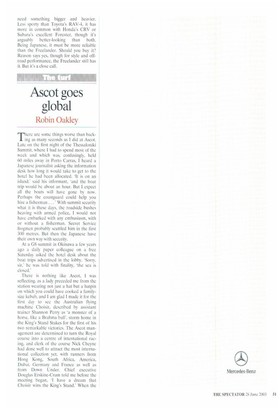Off-road competition
Alan Judd
The market for SUVs — so-called Sports Utility Vehicles — continues to grow despite claims that it has peaked, and despite the mumping and mewling of the Lib Dem MP for Lewes, who wants to force us by law into small cars. Sadly, encouragement of individual choice never was his party's strongest point.
SUVs are mostly 4x4s designed more for road than cross-country use. Smaller than their more agrarian 4x4 cousins, they're partly fashion statement and partly a triumph of consumer demand, both over an industry reluctant to build boxes on wheels and over motoring journalists who prefer hot little numbers that leave smoking rubber on corners. The consumers' point is that they prefer sitting upright in spacious, comfortable boxes with good visibility and a sense of physical security, and don't mind slowing down on corners. In 1995 about a quarter of European 4x4 sales were SUVs; by 2005 it's expected to be about half, with most of the extra sales coming not from owners of larger 4x4s but from people who previously drove saloons and estates. In Britain. 4x4 sales now exceed those of executive cars, with 74 per cent of SUV buyers never having had a 4x4 before, and 40 per cent of those being women.
Among newer SUVs the Nissan X-Trail six-speed, 2.2-litre diesel has had a very good press since its launch in 2001. It's a lively, frugal performer (urban 30.7mpg, extra-urban 47.1, combined 39.2) with a compact but reasonably capacious body that combines good roof height without anyone needing a ladder to climb into • it. At prices ranging from £16,750 for the 2.0 S petrol model to £20,895 for the 2.2D SVE, it competes head-on with LandRover's Freelander (£15,995-£20,900), bestselling SUV and the vehicle with the highest return rate under warranty. (If a Freelander tempts you, get the diesel, since most serious problems are with the K series petrol engines, which have porous blocks.) First impressions of the 2.2 SVE are of a neat and contained rather than aggressive or flamboyant vehicle, with ease of access and egress immediately apparent. The seats — leather in this version — are large, sensibly adjustable, not too fiddly, with good lumbar support. Cabin ergonomics are thoughtful and simple, with three clear central dials slightly angled towards the driver and a wide, easily found footrest. The controls have a quality feel, though their cheap silvery capping gives them rather a toy-town look. The CD, radio and climate control are straightforward and efficient. A brace of retractable, air-conditioned drinks-can holders will doubtless be a selling point for some.
Safety is enhanced by front and side airbags, while the rear seats, when folded, contribute to a hard, washable resin floor surface, the boot part of which is removable. You can close the roof-hinged tailgate without dirtying your fingers. The common-rail diesel (power 114 PS, torque 199 lbs-ft) is plenty willing enough, although in all but top gear there's a slight clatter, like the noise your bike used to make when you jammed a piece of cardboard against the spokes. There's also a whine, especially when you ease off between gears. This may be because of the under-bonnet soundproofing, which doesn't look as thick as that in my (quieter) Discovery. Tyre noise is also evident. But the crisp, six-speed gearbox is a delight, slotting through the cogs with a precision that makes Discovery gear-changing resemble the EU Common Agricultural Policy negotiations.
Sophisticated electronics make the ride more estate-car-like than in most 4x4s, controlling not only the ABS and stability programme but also the three-stage fourwheel-drive system. This means your normal driving is in the more economical twowheel drive, converting to four at the press of one button (at any speed) and locking into it at the press of another. There's no low-ratio gearbox or manual differential lock, but torque is electronically distributed according to traction, with only a few degrees of slip permitted any wheel. Maximum towing weight is 2 tonnes.
Overall, it's a fairly light and carefree drive, relaxing despite the mild noise intrusion, yet you feel there's a solid base to the vehicle and that a deal of thought has gone into it. It's more than capable of everything that most drivers are likely to demand, unless you want to tow heavy loads across country, in which case you need something bigger and heavier. Less sporty than Toyota's RAV-4, it has more in common with Honda's CRV or Subaru's excellent Forester, though it's arguably better-looking than both. Being Japanese, it must be more reliable than the Free'ander. Should you buy it? Reason says yes, though for style and offroad performance, the Freelander still has it. But it's a close call.



































































 Previous page
Previous page